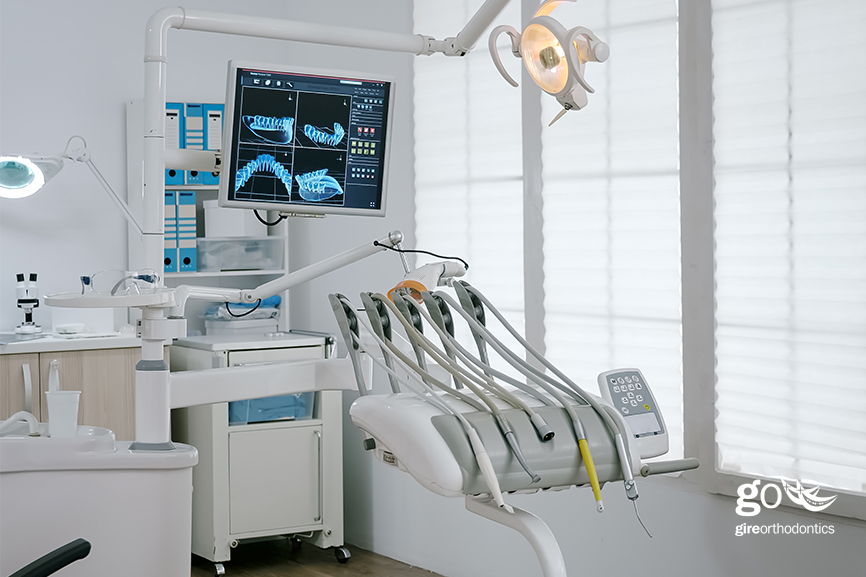La Habra/Chino Hills, CA – When people of a certain age think of orthodontic treatment, they conjure up an image that is wildly different from today’s orthodontic treatment. Gone are the days of bulky headgear and conspicuous metal. Today’s orthodontic patients benefit from advances in technology that have resulted in more discreet, comfortable, and faster treatment than ever before.
Dr. Robert Gire of Gire Orthodontics explains how technological breakthroughs have revolutionized the orthodontic world.
- 3D printing. 3D printing is changing the way orthodontic appliances are made. This technology has been used for a while to create aligners and retainers, but now it is being used to create completely customized brackets, expanders, and indirect bonding trays. 3D printing allows us to provide patients with the most customized treatment possible because it offers a better fit, resulting in increased comfort and even more precise treatment.
- Virtual care with remote monitoring. COVID changed the way we provided care, encouraging practices to embrace virtual consultations and remote care. Smart dental monitoring tools now allow patients to visit their orthodontist without having to physically come to an office. You can take high-resolution images and scans in the comfort of your home and send them right to your orthodontist. We can then track your progress and make adjustments, all while saving you time and travel. This also makes receiving care much easier for patients in rural or underserved areas of the country.
- Clear aligners with smart features. It seems like every aspect of our lives is becoming “smart,” and your aligner treatment is no different. The newest generation of clear aligners has smart features, such as sensors that allow us to track if you’re wearing the aligners. These sensors can also help us monitor oral health issues and can even alert the patient when it’s time to switch to a new set of aligners.
- Treatment planning powered by AI. AI has been infused into everyday life, and it’s making it easier to plan orthodontic treatment. Advanced AI algorithms can now analyze digital scans and X-rays, detecting issues sooner and suggesting the ideal treatment plan based on real-life cases. AI allows us to reduce human error, resulting in shorter treatment times and more predictable outcomes.
- Microperforations and molecular targeting. These advances may be able to help speed up treatment times, without compromising your outcomes. Research is showing that microperforations, or tiny holes placed strategically in the bone near teeth, can actually activate biological pathways that play important roles in bone remodeling. If we can stimulate the body’s natural healing and bone remodeling processes, these microperforations might be able to help move teeth even faster. This could potentially shorten treatment times drastically.
- Smart soothers. Say goodbye to pacifiers to soothe babies and hello to being able to prevent bite issues. Companies like Curaprox have invented smart soothers that are redesigned and orthodontically informed. For years, pacifiers have soothed infants, but also been linked to bite issues such as open bites and crossbites. Now, this innovative product can not only help soothe your baby, but also promote proper tongue placement and support ideal jaw development. This new, technologically advanced breed of pacifiers may be able to prevent the need for future orthodontic treatment.
- Autophagy-driven orthodontics. Autophagy is the body’s way of removing damaged cells and regenerating new ones. And now, it has implications for use in the orthodontic world. Researchers have been exploring how autophagy can be used to remodel bone and periodontal structures during orthodontic treatment. This could allow for more efficient tooth movement, making treatment more biologically responsive. And that could mean faster treatment times and increased comfort for patients, if successful.
- Robotics. Robotics have been used in medicine for many years, and now we’re seeing how it can impact the orthodontic world. Robotic arms can do tasks such as wire bending and bracket placement more consistently and quicker than manual methods. This benefits our patients because they can spend less time in our chairs.
- Genetic testing. Genetic testing allows us to provide the most customized treatment possible. A simple DNA test can tell us how well a certain patient will respond to treatment, allowing us to choose the very best course of action possible. We can identify any risks or underlying issues that could impact treatment, allowing us to provide the best care possible.
But it doesn’t stop there – breakthroughs in the orthodontic world are happening every day, and there continue to be exciting things on the horizon. At Gire Orthodontics, we’re committed to staying at the forefront of the technological world so that we can always provide our patients with the very best care possible.
Advances in technology allow us to provide care that is faster, more precise, and more comfortable than ever before. Discover how Dr. Gire can transform your smile by calling us today at 562-690-1199 (La Habra) or 909-393-9911 (Chino Hills).
